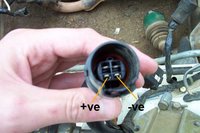Difference between revisions of "First Generation Magna EFI Self Diagnosis"
Cartman02au (talk | contribs) |
Cartman02au (talk | contribs) |
||
| Line 26: | Line 26: | ||
[[Category: First Generation Workshop|E]] | [[Category: First Generation Workshop|E]] | ||
| + | [[Category: Astron Engines|E]] | ||
Latest revision as of 02:34, 13 September 2020
The Electronic Control Unit for the EFI System on your TN or TP Magna can help you track down problems with the EFI system.
Apart from adjusting fuel/air ratios, timing and the like - the ECU can also diagnose some problems within the system. The ECU can output these as "trouble codes" when needed. The ECU keeps these in memory until you erase it's memory.
Setting Up
Setting up is fairly easy, locate the engine service connector located near the coil on the left-hand (passenger) side of the engine bay. This should have a little black plug in it. Remove the plug and hook an analog voltmeter to it as shown in the picture. (you may also use an LED to do this test.)
Reading the codes
If the engine is unable to run switch the ignition to the ON position and watch the sweeps on the needle. If the engine can run start the car and watch the needle.
Each code is shown by a series of 1.5 second and 0.5 second pulses, with a 3 second leading pulse indicating the beginning of a code. The codes are:
- SSSSS - Everything OK
- LSSSS - Oxygen Sensor
- SLLSS - Crank Angle Sensor
- LLSSS - Air Flow Meter
- SSLSS - Atmospheric Pressure Sensor
- LSLSS - Throttle Position Sensor
- SLLSS - Motor Position Sensor
- LLLSS - Coolant Temperature Sensor
- SSSLS - No1 Cylinder Sensor
If you are doing the test with the car not running, it is normal for the oxygen sensor to be displayed. If the oxygen sensor error is displayed, run the car above 2000rpm for 30 seconds and check if the error has been cleared.
